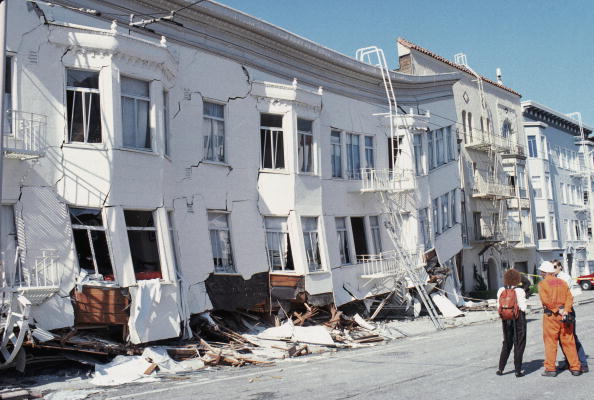
Getty Image / Otto Greule Jr / Stringer
SAN FRANCISCO - OCTOBER 17: General view of the Marina district disaster zone after an earthquake, measuring 7.1 on the richter scale, rocks game three of the World Series between the Oakland A's and San Francisco Giants at Candlestick Park on October 17, 1989 in San Francisco, California. Despite some discussion to cancel, baseball Commissioner Fay Vincent agrees to allow the series to continue. Play resumed October 25, and the A's go on to sweep the Giants in four games. (Photo by Otto Greule Jr /Getty Images)
This week, a reminder that California is highly susceptible and overdue for a huge earthquake was provided when a series of relatively small quakes rattled the San Francisco area. On Monday morning, a 4.6-magnitude earthquake hit Monterey County in California followed by a swarm of nine smaller aftershocks. The earthquake occurred four miles from the San Andreas fault line and tremors were felt as far as San Francisco which is more than 90 miles away. Scientists believe that small earthquakes near major faults can be a precursor of much larger seismic events, which has people wondering if the “Big One” is coming.
“Big earthquakes can come in clusters. And one can trigger the other,” said U.S. Geological Survey seismologist Ned Field, the lead author of the new forecasting model report. Scientists including Field believe small earthquakes that strike near a major fault line indicates “increased stress in that area” and “even the biggest earthquake has to start out small.” “If you have more little things popping off, you have more opportunities for one of those to grow into something big,” Field said.
The most recent major earthquakes that rattled California include a 6.9-magnitude earthquake that happened on October 17, 1989, in Loma Prieta that killed 64 people and damaged 16,000 homes and a magnitude 7.3 quake that slammed Landers on June 28, 1992. The San Andreas Fault is long overdue for another major earthquake and maybe even the “Big One.”
Three years ago, the U.S. Geological Survey increased the chances that California would be rocked by a 6.7-magnitude earthquake in the next 30 years to more than a 99% possibility and a 7-magnitude quake is at 93%. The likelihood of a 7.5-magnitude or greater earthquake is 48% in the next 30 years. Up from 4.6%, there is a 7% chance of a catastrophic mega-quake of 8 magnitude, which happens about once every 500 years on average. Scientists believe that a 7.8-magnitude quake could kill over 1,800 people and destroy or badly damage 300,000 buildings. Researchers estimate that the San Andreas Fault, which stretches 750 miles across California, has the potential to unleash a mega-earthquake of up to 9.2 on the Richter scale, which would be an end of days type of calamity.
In the rest of the world, two months ago, a 7.1-magnitude earthquake ravaged parts of Mexico City and easily toppled buildings where there were 369 casualties. There was a 7.3-magnitude earthquake in Halabjah, Iraq on Nov. 12, which killed over 530 and is the deadliest quake of 2017, an 8.2-magnitude quake in Tres Picos, Mexico on Sept. 8, and a 7.7-magnitude earthquake in Nikol’skoye, Russia on July 17. Not to mention how active Yellowstone National Park has been. Some experts believe that if a supervolcano erupts in the middle of the U.S. it could spell disaster. Have a great day!